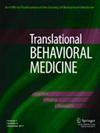Translating a motivational interviewing intervention for childhood cancer survivors into an eHealth tool: A user-centered design process.
IF 3.6
3区 医学
Q1 PUBLIC, ENVIRONMENTAL & OCCUPATIONAL HEALTH
引用次数: 0
Abstract
Childhood cancer survivors have a higher risk of developing cardiomyopathy than members of the general population. Screening echocardiograms can facilitate early detection and treatment of cardiomyopathy. Furthermore, motivational interviewing can increase uptake of cardiac screening. However, such approaches are time- and resource-intensive, which limits their reach to the survivors who need them. We describe how we utilized a user-centered design process to translate an in-person motivational interviewing intervention into an eHealth tool to improve cardiac screening among childhood cancer survivors. We used an iterative, three-phase, user-centered design approach: (i) setting the stage (convening advisory boards and reviewing the original intervention), (ii) content programming and development (writing and programming intervention text and flow), and (iii) intervention testing (research team testing and cognitive interviews.) For cognitive interviews, participants were recruited via institutional participant registries and medical records. Data were analyzed using rapid qualitative analysis. During Phase 1, we identified survivor and provider advisors and outlined elements of the in-person intervention to change for the eHealth tool. During Phases 2 and 3, advisors recommended several modifications that guided the final intervention content and flow. Examples include: acknowledging potential hesitation or apprehension surrounding medical screenings, addressing barriers and facilitators to obtaining screening, and improving the tool's usability and appeal. In Phase 3, cognitive interview participants suggested additional refinements to the intervention language. This translation process shows that continued in-depth engagement of community advisors and iterative testing can improve the applicability of an eHealth to survivors' lived experiences and social contexts.将针对儿童癌症幸存者的动机访谈干预转化为电子健康工具:以用户为中心的设计过程。
与普通人相比,儿童癌症幸存者患心肌病的风险更高。超声心动图筛查有助于早期发现和治疗心肌病。此外,动机访谈也能提高心脏筛查的接受率。然而,这些方法需要耗费大量的时间和资源,这就限制了它们对有需要的幸存者的覆盖范围。我们介绍了如何利用以用户为中心的设计流程,将面对面的动机访谈干预转化为电子健康工具,以提高儿童癌症幸存者的心脏筛查率。我们采用了迭代、三阶段、以用户为中心的设计方法:(i) 设定阶段(召集咨询委员会并审查原始干预措施),(ii) 内容编程和开发(编写干预措施文本和流程并进行编程),(iii) 干预措施测试(研究小组测试和认知访谈。数据采用快速定性分析法进行分析。在第 1 阶段,我们确定了幸存者和提供者顾问,并概述了为改变电子健康工具而进行的面对面干预的要素。在第 2 和第 3 阶段,顾问们提出了几项修改建议,为最终的干预内容和流程提供了指导。例如:承认围绕医疗筛查可能存在的犹豫或忧虑,解决获得筛查的障碍和促进因素,以及提高工具的可用性和吸引力。在第 3 阶段,认知访谈参与者对干预语言提出了更多改进建议。这一翻译过程表明,社区顾问的持续深入参与和反复测试可以提高电子健康工具对幸存者生活经历和社会环境的适用性。
本文章由计算机程序翻译,如有差异,请以英文原文为准。
求助全文
约1分钟内获得全文
求助全文
来源期刊

Translational Behavioral Medicine
PUBLIC, ENVIRONMENTAL & OCCUPATIONAL HEALTH -
CiteScore
6.80
自引率
0.00%
发文量
87
期刊介绍:
Translational Behavioral Medicine publishes content that engages, informs, and catalyzes dialogue about behavioral medicine among the research, practice, and policy communities. TBM began receiving an Impact Factor in 2015 and currently holds an Impact Factor of 2.989.
TBM is one of two journals published by the Society of Behavioral Medicine. The Society of Behavioral Medicine is a multidisciplinary organization of clinicians, educators, and scientists dedicated to promoting the study of the interactions of behavior with biology and the environment, and then applying that knowledge to improve the health and well-being of individuals, families, communities, and populations.
 求助内容:
求助内容: 应助结果提醒方式:
应助结果提醒方式:


